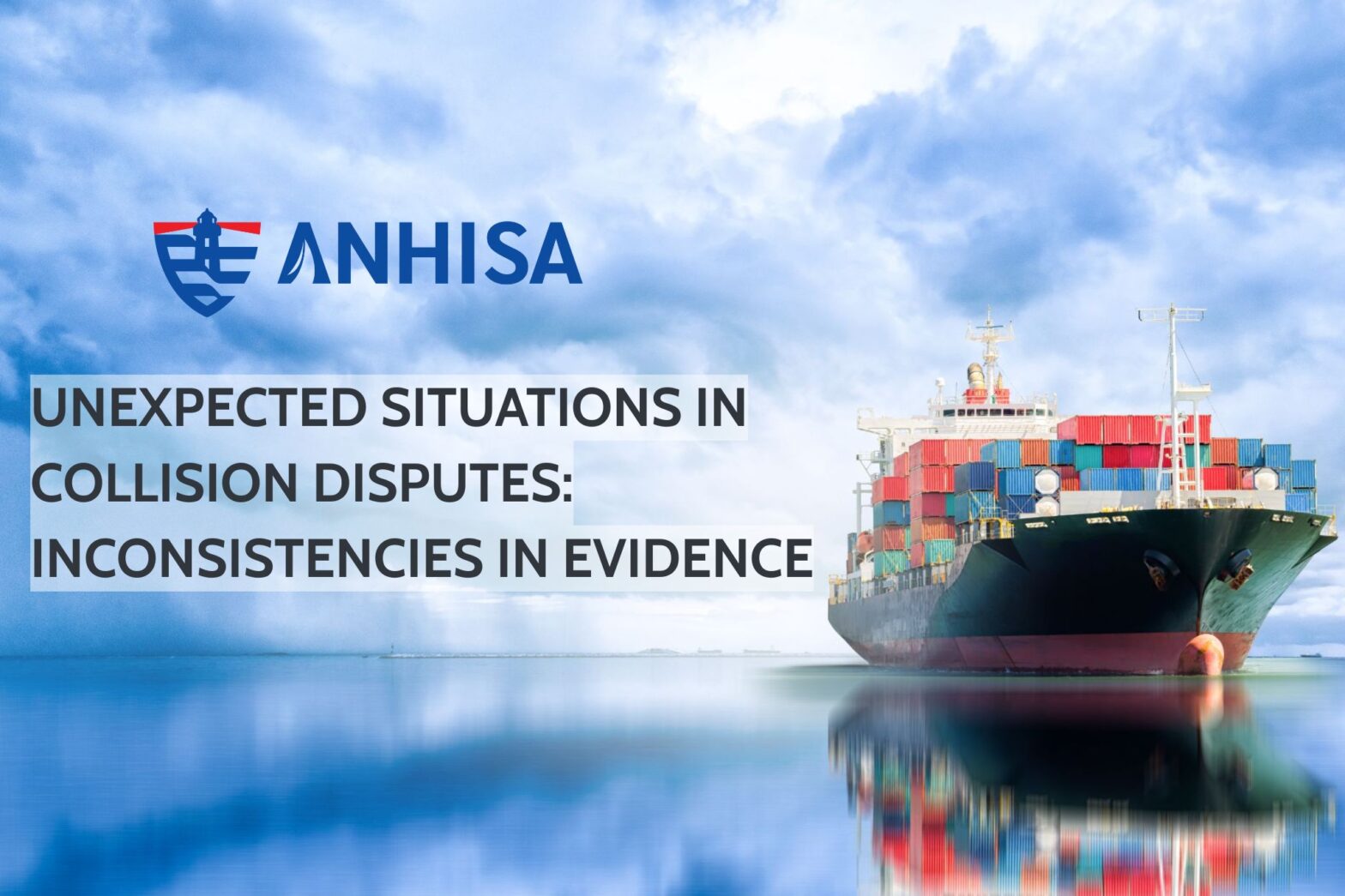Foreword
Over many years of engaging in litigation related to collisions, our legal team has encountered numerous unexpected situations with respect to the evidence presented by opposing parties in court. One particular case from four years ago involved a container vessel that, due to a lack of proper lookout, collided with a bulk carrier during its voyage. Following the collision, the container vessel and all cargo were completely submerged, while the bulk carrier sustained only minor damage. Fortunately, the crew of the container vessel was promptly rescued by the bulk carrier, which then continued on its itinerary.
Five months after the incident, the container vessel owner (“Claimant”) filed a lawsuit against the bulk carrier owner (“Respondent”) in court, requesting full compensation for damages related to the hull of the vessel, the cargo on board, and the lost wages of the crew. At the time of submitting a statement of claim, the Claimant submitted the original survey report from an independent inspection organization they had appointed, along with copies of this document, to the Respondent.
The Respondent received the complete set of documents and provided them to our legal team one month later. Upon reviewing the entire case file, it was noted that the survey report from the Claimant stated that the apportionment of liability between the Claimant and the Respondent was 90:10 in favor of the Respondent.
The Contradiction in Evidence Presented by the Same Party
During the conciliation session, we utilized the survey report provided by the Claimant, which indicated the Respondent’s blame ratio at 10% while attributing 90% of the blame to the Claimant. This evidence was instrumental in demonstrating that the Claimant acknowledged the primary cause of the accident was attributable to their own actions. Consequently, in the spirit of amicably resolving the matter swiftly, we suggested that the Claimant consider reducing their claim for damages to 10% of the total loss.
However, it was unexpected that the court informed us that they had not received any documentation from the Claimant indicating the 10:90 blame ratio in favor of the Respondent; instead, the only report available indicated this ratio of 10:90 in favor of the Claimant. As a result, the Claimant insisted on maintaining their unreasonably high compensation demand based on this basis.
Upon cross-referencing both survey reports retained by the court and the copy provided to our client, it was observed that both were issued by the same inspection organization and contained identical content, differing only in the stated blame ratio.

Reasons Behind Discrepancies in Survey Reports from the Same Inspection Organization
Upon thorough examination, we identified that the inconsistencies in survey reports issued by the same inspection organization during litigation might stem from two potential causes:
- The party submitting the evidence may have altered the page containing the blame ratio to reflect a 10:90 split and subsequently forged the seal to authenticate the amended page.
- Alternatively, the discrepancies might result from an error within the inspection organization itself during the report issuance process. In fact, surveyors appointed by parties in collision cases serve dual roles: they act as independent third parties providing an assessment of the incident while also functioning as service providers to the party that appointed them. Consequently, the content of their survey reports may sometimes lack the independence and objectivity required for a fair resolution. Therefore, we did not rule out the possibility that the inspection organization in this case may have been influenced by their client, the Claimant, to amend the results of the inspection report.
Addressing Discrepancies in Survey Reports from the Same Inspection Organization
Form of Evidence
Recognizing the inconsistencies within the same document provided by the Claimant, we immediately contested this evidence and requested that the court reevaluate its validity. The Claimant argued that the document held by the court was the original, while our document was merely a copy and therefore lacked legal standing in court.
Types of Survey Reports
It is noteworthy that in the field of surveying, the inspection organization commonly issues one original report and multiple copies for client convenience. However, all original reports and copies are generally signed by the surveyor and stamped by the inspection organization. Given that our document retained the complete seal and signature from the inspection organization, we immediately requested the court to summon a representative from the inspection organization to clarify the discrepancies in the documents issued by this entity.
Approach to Resolving Evidence Discrepancies
After the conciliation session, we promptly sent a letter requesting that the Claimant withdraw the document containing signs of forgery. [1]Simultaneously, we submitted a request for a signature and seal verification of both documents to the court and the procuracy. Furthermore, to prevent any collusion between the inspection organization and the Claimant from presenting false testimony in court, we served all requests we had sent to the Claimant and the court at the address of the inspection organization. In the event that this organization provides false evidence or testimony, the results of the signature verification would serve as incriminating evidence against them, exposing them to potential administrative and even criminal penalties.

Outcome: Swift Resolution Through Conciliation Agreement
In practice, the apportionment of liability is a crucial issue in resolving collision disputes. Hence in most litigation cases, parties often engage in heated arguments over blame ratio. This debate can prolong for months or even years if parties stubbornly maintain their positions. Our challenge to the validity of the survey report, which the Claimant relied upon as the basis for blame ratio, compelled the Claimant to reconsider and propose a reasonable amount for swift resolution through a settlement agreement.
Reflection: Caution in Apportionment of Liability Based on Survey Reports
Reliability of the Survey Report
The survey report from an inspection organization may be regarded as a reference document to determine the blame ratio among parties. However, the lack of comprehensive independence, potentially influenced by the appointing client, can render the survey report unreliable.
Proposed Solution
When encountering any signs of forgery or inconsistencies submitted to the court, it is essential to conduct a comprehensive evaluation of potential parties that may influence and falsify evidence. Once the relevant parties are identified, an effective resolution involves requesting the court to summon an expert examination of the evidence, submitting a letter requesting the submission of false evidence to be retracted, and notifying all relevant parties about the examination request to ensure they consider the potential legal consequences and penalties they may face. This process enhances the effectiveness of negotiation or dispute resolution in court.
[1]Article 103.1 of the Civil Procedure Code 2015
ANHISA LLC AND OUR EXPERTISE
ANHISA LLC is a boutique law firm specializing in Dispute Resolution, Shipping and Aviation. Being the leading lawyers in various fields of law, our qualified, experienced, and supportive team of lawyers know how to best proceed with a case against or in relation to Vietnamese parties and are well equipped to provide clients with cost-effective and innovative solutions to their problems.
Regarding dispute resolution, we have represented Vietnamese and foreign clients in the resolution of disputes involving maritime, construction, commercial and civil matters. Our lawyers are well-equipped to offer services on a wide range of disputes and conflicts, whether cross-border or purely domestic, to appear before any Judges or Arbitral Tribunals. The firm is prepared to assist clients in designing the appropriate dispute resolution procedure to help resolve conflicts as efficiently and cost effectively as possible, which may involve combining elements of mediation and other methods such as arbitration.
AUTHORS
DANG VIET ANH
Managing Partner
Mobile: (+84) 983 467070
Email: [email protected]
TRUONG CONG HONG
Senior Associate
Mobile: (+84) 909 814090
Email: [email protected]
TRAN THI BAO TRAM
Associate
Mobile: (+84) 332 245449
Email: [email protected]
This article aims to furnish our clients and contacts with general information on the relevant topic for reference purposes only, without creating any duty of care on the part of ANHISA. The information presented herein is not intended to serve, nor should it be considered, as a substitute for legal or other professional advice.
